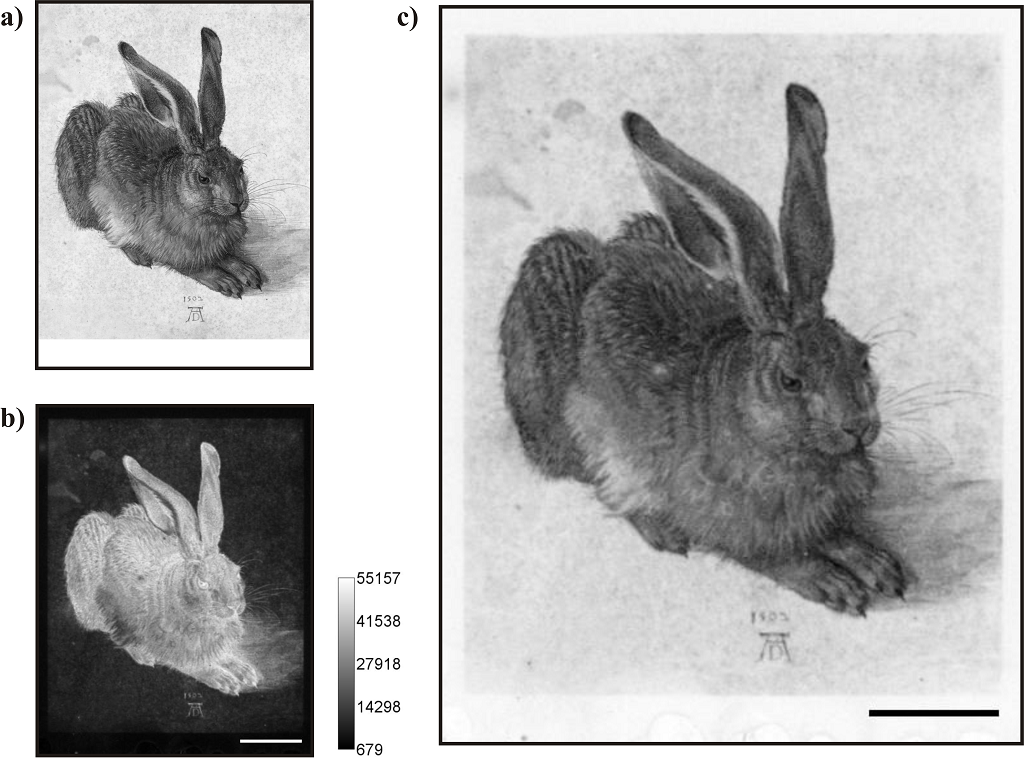|
Protein patterns of different shapes and densities are useful tools for studies of cell behavior and to create biomaterials that induce specific cellular responses. Up to now the dominant techniques for creating protein patterns are mostly based on serial writing processes or require templates such as photomasks or elastomer stamps. Only a few of these techniques permit the creation of grayscale patterns. To create such patterns in a faster way the group developed a maskless projection lithography setup based on a digital mirror device. That allows fast patterning of proteins by immobilizing fluorescently labeled molecules via photobleaching. Grayscale patterns of biotin with pixel sizes in the range of 2.5 μm are generated within 10 s of exposure on an area of about 5 mm2 . This maskless projection lithography method permits the rapid and inexpensive generation of protein patterns definable by any user-defined grayscale digital image on substrate areas in the mm2 to cm2 range. |
 |
|
Illustration of image quality obtained by the maskless DMD-based lithography system. a) Original image. b) Pattern of F5B after 10 s of exposure and staining with streptavidin-Cy3 (fluorescence image taken with a photomultiplier gain of 700). c) Inverted image of (b). Frames indicate the outline of the images in the case of the original image and the fl uorescence image to indicate exposed and nonilluminated sample areas and background. Scale bar: 500 μm. |
Associated Publications
Journal Papers
T. M. Nargang, M. Runck, D. Helmer, B. E. Rapp: "Functionalization of paper using photobleaching: a fast and convenient method for creating paper-based assays with colorimetric and fluorescent readout", Engineering in Life Sciences, 2016 | Link
B. Waterkotte, F. Bally, P. M. Nikolov, A. Waldbaur, B. E. Rapp, R. Truckenmüller, J. Lahann, K. Schmitz, S. Giselbrecht: “Biofunctional Micropatterning of Thermoformed 3D Substrates”, Advanced Functional Materials, 24, 4, 442-450, 2014 | Link
A. Waldbaur, B. Waterkotte, K. Schmitz, B. E. Rapp: “Maskless projection lithography for the fast and flexible generation of grayscale protein patterns”, Small, 8, 10, 1570-1578, 2012 | Link
Reviews
Books and Book chapters
Conference Contributions
S. Eckes, T. M. Nargang, B. E. Rapp, K. Schmitz: "Light-induced Chemokine Patterning of Surfaces", poster, 2nd European Chemokine and Cell Migration Conference", Cardiff, England, 2017
T. M. Nargang, F. Kotz, N. Keller, D. Helmer, B. E. Rapp: “Rapid structuring of proteins on filter paper using lithography”, talk, SPIE Photonics West, San Francisco, USA, 2017| Link
E. Wilhelm, T. M. Nargang, B. Waterkotte, B. E. Rapp: “Protein assay structured on paper by using lithography”, talk, SPIE Photonics West, San Francisco, USA, 2015| Link
E. Wilhelm, C. Neumann, K. Sachsenheimer, K. Länge, B. E. Rapp: “UV-light structured silanization for selective bonding and fabrication of paper-based microfluidic channels”, poster, 18th International Conference on Miniaturized Systems for Chemistry and Life Sciences (µTAS), San Antonio, USA, 2014
B. Waterkotte, A. Waldbaur, B. E. Rapp: “Creating protein patterns with light by means of maskless projection lithography”, poster, Functional Genomics & Proteomics, Frankfurt a. M., Germany, 2013
A. Waldbaur, B. Waterkotte, J. Leuthold, K. Schmitz, B. E. Rapp: “Rapid biochemical functionalization of technical surfaces by means of a photobleaching-based maskless projection lithography process”, talk, SPIE Photonics West, San Francisco, USA, 2013| Link
Patents
Miscellaneous
D. Helmer, B. E. Rapp: "Healthcare Material Platforms", HEALTH 2, Paneuropean Network, 2017. The NeptunLab is features on the cover page of the issue | Link | Cover
